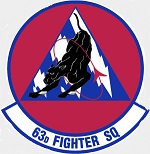Hobby Master HA8406 USAAF Republic P-47M Thunderbolt Fighter - Capt. John. C. Fahringer, "Devastatin' Deb," 63rd Fighter Squadron "Panthers", RAF Kings Cliffe, March 1945 (1:48 Scale)
"Why should we have a navy at all? There are no enemies for it to fight except apparently the Army Air Force."
- General Carl Spaatz, Commander of the US 8th Army Air Force, after WWII
 Nicknamed the "Jug" for its bulky shape, the Republic P-47 Thunderbolt was considered a monster of a machine. Despite its size, the Thunderbolt proved to be a fast and maneuverable warbird able to hold its own in combat. In fact, when Allied pilots climbed aboard a P-47, they knew the were in control of a fighting machine with enormous power. More importantly, they knew that if their aircraft was hit but gunfire, they had an excellent chance of making it home.
Nicknamed the "Jug" for its bulky shape, the Republic P-47 Thunderbolt was considered a monster of a machine. Despite its size, the Thunderbolt proved to be a fast and maneuverable warbird able to hold its own in combat. In fact, when Allied pilots climbed aboard a P-47, they knew the were in control of a fighting machine with enormous power. More importantly, they knew that if their aircraft was hit but gunfire, they had an excellent chance of making it home.
The P-47M was a more conservative attempt to come up with a higher-performance ("Sprint") version of the Thunderbolt, designed to chase V-1 flying bombs, done, in part, by reducing armament from eight .50-caliber Colt-Browning M2 machine guns to six. In September 1944, four P-47D-27-RE airframes (42-27385/27388) were modified into prototype YP-47Ms by fitting the R-2800-57 engine and the GE CH-5 turbo-supercharger, a combination which could produce 2,800 hp (2,089 kW) at 32,500 ft (9,900 m) when using Wartime Emergency Power (water injection). Air brakes were added to the wing's lower surfaces to allow braking after a dive onto its prey.
The YP-47M had a top speed of 473 mph (410 kn, 761 km/h) and it was put into limited production with 133 (sufficient for one group) built. However, the type suffered serious teething problems in the field due to the highly tuned engine. Engines were unable to reach operating temperatures and power settings and frequently failed in early flights from a variety of causes: ignition harnesses cracked at high altitudes, severing electrical connections between the magneto and distributor, and carburetor valve diaphragms also failed. Persistent oil tank ruptures in replacement engines were found to be the result of inadequate protection against saltwater corrosion during transshipment. In the end, it was simply errors made by the R-2800-57 model engine's manufacturers which led to these issues with the P-47M.
By the time the bugs were worked out, the war in Europe was nearly over. However, P-47Ms still destroyed 15 enemy aircraft in aerial combat, normal results for any fighter type in March-May 1945 when aerial encounters with the Luftwaffe were rare. The entire production total of 130 P-47Ms were delivered to the 56th Fighter Group, and were responsible for all seven of that group's jet shoot-downs. Twelve were lost in operational crashes with the 56th Group resulting in 11 deaths, two after VE Day, and two (44-21134 on April 13th, 1945 and 44-21230 on April 16th, 1945) were shot down in combat (both by ground fire).
Pictured here is a 1:48 scale replica of a P-47M Thunderbolt fighter that was piloted by Capt. John. C. Fahringer, and nicknamed "Devastatin' Deb," which was attached to the 63rd Fighter Squadron "Panthers", then deployed to RAF Kings Cliffe, during March 1945.
Sold Out!
Dimensions:
Wingspan: 10-inches
Length: 8-3/4-inches
Release Date: March 2014
 Historical Account: "Devastin' Deb" - During his time with the 63rd Fighter Squadron, Capt. John C Fahringer flew two P-47s. Both aircraft wore UN-F and were named "Devastin' Deb". The first aircraft was a P-47D while the second was a P-47M 44-21160. On March 25th, 1945, 44-21160 was flown by Major George Bostwick, newly assigned to the 63rd Fighter Squadron, when he shot down an Me-262 and damaged another. On April 5th, 1945, Captain Fahringer, Operations Officer for the 63rd, scored his fourth and final aircraft when he downed an Me-262 while flying flying "Devastin' Deb".
Historical Account: "Devastin' Deb" - During his time with the 63rd Fighter Squadron, Capt. John C Fahringer flew two P-47s. Both aircraft wore UN-F and were named "Devastin' Deb". The first aircraft was a P-47D while the second was a P-47M 44-21160. On March 25th, 1945, 44-21160 was flown by Major George Bostwick, newly assigned to the 63rd Fighter Squadron, when he shot down an Me-262 and damaged another. On April 5th, 1945, Captain Fahringer, Operations Officer for the 63rd, scored his fourth and final aircraft when he downed an Me-262 while flying flying "Devastin' Deb".








